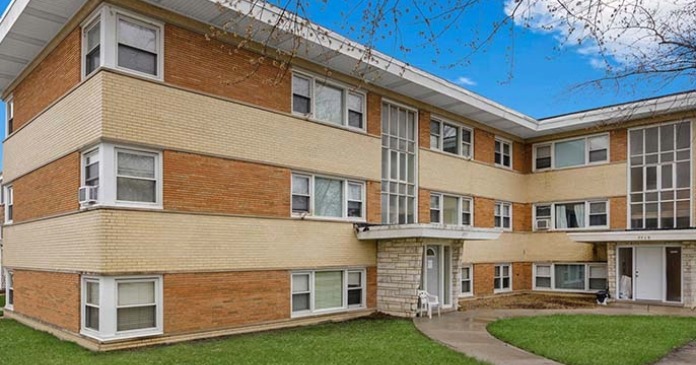A WalletHub study looked into the share of median household income that would be required to pay the median rent plus energy costs. The state-by-state rankings are shown below:
Source: WalletHub
| Rank | State | Cost of housing as share of median monthly household income |
| 1 | New York | 54.52% |
| 2 | Hawaii | 52.88% |
| 3 | Massachusetts | 48.78% |
| 4 | Florida | 42.64% |
| 5 | Maine | 41.78% |
| 6 | California | 41.76% |
| 7 | Illinois | 39.74% |
| 8 | Oregon | 38.03% |
| 9 | Vermont | 37.41% |
| 10 | Rhode Island | 36.01% |
| 11 | Connecticut | 34.41% |
| 12 | Maryland | 33.60% |
| 13 | South Carolina | 33.27% |
| 14 | Arizona | 32.24% |
| 15 | Kentucky | 31.45% |
| 16 | Louisiana | 30.90% |
| 17 | New Hampshire | 30.56% |
| 18 | Washington | 30.02% |
| 19 | Tennessee | 29.94% |
| 20 | New Mexico | 29.84% |
| 21 | North Carolina | 29.04% |
| 22 | Nevada | 28.97% |
| 23 | Michigan | 28.37% |
| 24 | Pennsylvania | 28.35% |
| 25 | New Jersey | 27.62% |
| 26 | Ohio | 27.47% |
| 27 | Wisconsin | 27.32% |
| 28 | Idaho | 27.27% |
| 29 | Montana | 27.01% |
| 30 | Delaware | 26.81% |
| 31 | Alaska | 26.52% |
| 32 | North Dakota | 26.00% |
| 33 | Colorado | 25.83% |
| 34 | Texas | 25.36% |
| 35 | Mississippi | 25.35% |
| 36 | Indiana | 25.29% |
| 37 | Missouri | 25.10% |
| 38 | Virginia | 25.03% |
| 39 | Alabama | 24.72% |
| 40 | West Virginia | 24.41% |
| 41 | Nebraska | 24.06% |
| 42 | Georgia | 24.00% |
| 43 | Arkansas | 23.56% |
| 44 | Utah | 22.71% |
| 45 | South Dakota | 22.48% |
| 46 | Oklahoma | 21.63% |
| 47 | Minnesota | 21.11% |
| 48 | Wyoming | 19.64% |
| 49 | Iowa | 19.32% |
| 50 | Kansas | 19.11% |
The Joint Center for Housing Studies reported last year that half of all renter households spent more than 30 percent of their incomes on rent plus utilities in 2022, the most recent year for which complete data is available. This is the threshold they set for designating a household as being “rent burdened”. Their state-by-state assessment of rent burden is shown in the table below.
|
State |
Moderately burdened (percent) | Severely burdened (percent) | Total burdened (percent) | |
| Florida | 26.3 | 31.4 | 57.8 | |
| Hawaii | 27.2 | 28.8 | 56.5 | |
| Nevada | 25.3 | 30.6 | 55.9 | |
| California | 24.4 | 29.4 | 53.8 | |
| Massachusetts | 24.0 | 27.7 | 51.8 | |
| Colorado | 24.9 | 26.1 | 51.1 | |
| Connecticut | 21.8 | 29.3 | 51.0 | |
| New Jersey | 23.2 | 27.7 | 51.0 | |
| Texas | 25.0 | 26.0 | 51.0 | |
| Louisiana | 21.9 | 28.9 | 50.8 | |
| Arizona | 24.8 | 25.8 | 50.8 | |
| New York | 20.8 | 29.9 | 50.7 | |
| Oregon | 23.6 | 27.0 | 50.5 | |
| Vermont | 21.6 | 28.4 | 50.0 | |
| Maryland | 23.7 | 26.2 | 49.9 | |
| New Mexico | 23.0 | 26.6 | 49.6 | |
| Georgia | 22.7 | 26.8 | 49.5 | |
| Minnesota | 22.9 | 26.2 | 49.1 | |
| Washington | 24.0 | 24.8 | 48.7 | |
| Michigan | 23.1 | 25.6 | 48.7 | |
| South Carolina | 21.9 | 26.5 | 48.6 | |
| Illinois | 20.8 | 27.2 | 48.0 | |
| Virginia | 21.9 | 25.8 | 47.6 | |
| Pennsylvania | 21.0 | 25.9 | 47.0 | |
| DC | 21.9 | 25.0 | 46.9 | |
| Alabama | 19.0 | 27.3 | 46.3 | |
| Indiana | 21.0 | 25.2 | 46.2 | |
| Kansas | 22.8 | 23.3 | 46.0 | |
| North Carolina | 22.2 | 23.2 | 45.4 | |
| Tennessee | 22.7 | 22.6 | 45.4 | |
| Mississippi | 20.3 | 24.7 | 45.1 | |
| Idaho | 23.2 | 21.7 | 44.9 | |
| West Virginia | 19.8 | 25.1 | 44.9 | |
| Oklahoma | 21.4 | 23.3 | 44.9 | |
| Ohio | 19.9 | 25.0 | 44.9 | |
| New Hampshire | 24.3 | 21.1 | 44.7 | |
| Delaware | 22.3 | 22.3 | 44.7 | |
| Utah | 21.8 | 22.7 | 44.5 | |
| Kentucky | 20.2 | 23.8 | 44.0 | |
| Rhode Island | 20.7 | 23.2 | 43.9 | |
| Missouri | 20.5 | 23.2 | 43.7 | |
| Wisconsin | 20.3 | 23.1 | 43.5 | |
| Nebraska | 22.1 | 21.4 | 43.5 | |
| Maine | 21.3 | 21.9 | 43.2 | |
| Iowa | 20.3 | 22.8 | 43.1 | |
| Arkansas | 18.1 | 23.5 | 41.7 | |
| Wyoming | 20.0 | 21.5 | 41.5 | |
| Montana | 19.0 | 21.8 | 40.8 | |
| Alaska | 19.6 | 18.5 | 38.0 | |
| South Dakota | 20.2 | 17.4 | 37.6 | |
| North Dakota | 15.4 | 21.4 | 36.8 |
States that rank high on one list also tend to rank high on the other, but the orders are not the same.













